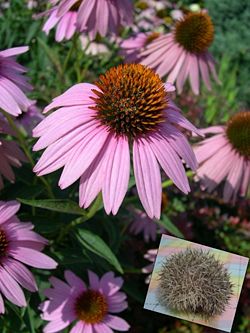Purple coneflower: Difference between revisions
Jump to navigation
Jump to search

Pat Palmer (talk | contribs) mNo edit summary |
Pat Palmer (talk | contribs) mNo edit summary |
||
| Line 1: | Line 1: | ||
{{subpages}} | {{subpages}} | ||
{{Image|Echinacea purpurea Spinus tristis JRVdH 10.jpg| | {{Image|Echinacea Purpea with hedgehog.jpg|right|250px|''Echinacea Purpea'', a.k.a. coneflower. Its name is derived from the Greek ''echinos'', meaning "hedgehog", due to resemblance of the central part of the flowering head to the spines of a coiled hedgehog, superimposed.}} | ||
{{Image|Echinacea purpurea Spinus tristis JRVdH 10.jpg|left|350px|A female American goldfinch eating the seeds from a purple coneflower seed pod.}} | |||
''' | ''Echinacea Purpea'', a.k.a. '''purple coneflower''' is one of nine [[Echinacea]] species. | ||
American goldfinches are uniquely adapted to eat the seeds of purple coneflowers and will often fly in during late summer to feast on the pods before continuing their migration southwards. | American goldfinches are uniquely adapted to eat the seeds of purple coneflowers and will often fly in during late summer to feast on the pods before continuing their migration southwards. | ||
Revision as of 08:19, 4 October 2022
Echinacea Purpea, a.k.a. purple coneflower is one of nine Echinacea species.
American goldfinches are uniquely adapted to eat the seeds of purple coneflowers and will often fly in during late summer to feast on the pods before continuing their migration southwards.

